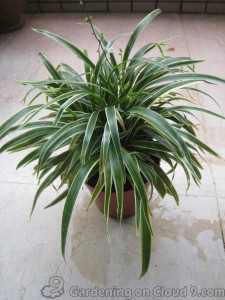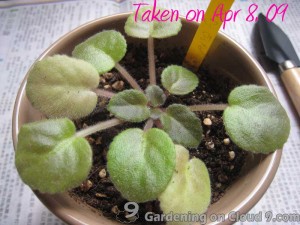|
|
By Sandy, on January 8th, 2010
Have you ever bought a Spider Plant (aka Airplane Plant, botanical name: Chlorophytum comosum) that just never grows “baby spiders”, or runners, no matter how well you take care of it? Instead of questioning your method of watering or fertilizing your Spider Plant, may be first of all, you should examine your plant and check whether or not it really is a Spider Plant! Because instead of a Spider Plant, it could be a Bichetii Grass.

Bichetii Grass (aka False Lily Turf, Siam Lily, botanical name: Chlorophytum bichetii) is in the same genus as Spider Plant, a very common variegated form of Chlorophytum laxum. Continue reading Is It Really a Spider Plant? Or a Bichetii Grass?
By Sandy, on July 15th, 2009
I bought a pot of Episcia (aka Flame Violet) seedling in October last year. Since then, it has been growing beautifully in my room, with its first flower blooming in April.

Thru some research, I have learned that Flame Violet can be propagated by stolon cuttings. This is my first time growing Flame Violet. Everything to me is new and interesting. And surely, I would like to try stolon propagation. While I was wondering when I should cut the stolons of my Flame Violet for my experiment, my dear brother accidently cut off two stolons from the plant with the rotor blades of his newly bought remote control helicopter. Ok. That’s great! At least I was saved from thinking too much more before taking any action. Continue reading Propagate Flame Violet by Cutting
By Sandy, on July 10th, 2009
I bought my first pot of African violet a few months ago. While the newly acquired African violet is blossoming beautifully, I didn’t aware but only until another gardener pointed out to me that my African violet actually had multiple crowns.
As a curious gardening novice who like to try different things, I decided to take up this challenge and separate the crowns. It has been almost three months since I separated the crowns. Seeing that the separated crowns of my African violets are now growing healthily, I consider this “operation” as a successful one. And here, let me share with you how I did it.

Continue reading African Violet Care – How to Separate Crowns
By Sandy, on June 7th, 2009
 When I found my Chinese Money Plant, Pilea peperomioides, blooming with some tiny white inflorescences last month, I knew that I was wrong when I told Louise that Chinese Money Plants never blossom … When I found my Chinese Money Plant, Pilea peperomioides, blooming with some tiny white inflorescences last month, I knew that I was wrong when I told Louise that Chinese Money Plants never blossom …
Besides Louise, I have a few other friends who guessed the plant that I used in my tabletop garden – Money Bowl is Nasturtium. Actually, it could be quite confusing since both plants have leaf stalks growing from the center of the leaf disks. Yet, it will be very easy to separate the two plants when they blossom.
Continue reading Chinese Money Plant & Nasturtium
By Sandy, on May 28th, 2009

Yes! After repotted my Ness Fantasy Gold to a smaller container for about six weeks, I have finally found a sign of life! My plant is finally growing! This has confirmed that my guess is right. Not only did I overwater my African violet, the ridiculously huge pot probably had caused rotten . . . → Read More: O Yes! Finally Started Growing!
By Sandy, on May 24th, 2009
 Everything of my cat grass was looking good until I’d found some mold on the cat grass on Day 14 🙁 I don’t know what has caused the mold. But before I find out how to deal with this mold problem, I’ve just moved my bowl of cat grass to the balcony. Hopefully, better air circulation will ease the problem a bit. Everything of my cat grass was looking good until I’d found some mold on the cat grass on Day 14 🙁 I don’t know what has caused the mold. But before I find out how to deal with this mold problem, I’ve just moved my bowl of cat grass to the balcony. Hopefully, better air circulation will ease the problem a bit.
Continue reading Cat Grass Day 14 – Mold on My Cat Grass
By Sandy, on May 22nd, 2009
 When I was doing some research on the benefits of cat grass for cats and other pets, I got all confused and was starting to wonder if what I am growing now is actually not cat grass. When I was doing some research on the benefits of cat grass for cats and other pets, I got all confused and was starting to wonder if what I am growing now is actually not cat grass.
After more research, I have learned that the term “cat grass” is quite a loose term. In many websites, cat grass actually includes a large number of young grass species. Common oat, flax, barley, and even catnip (Nepeta cataria) which is not even a grass at all, are called cat grass in many websites.
Continue reading Cat Grass or Wheatgrass?
By Sandy, on April 18th, 2009
While we are familiar with the common names of our houseplants, most of us do not know the botanical name of our plants. This is totally fine, for it is absolutely not necessary to memorize those long, daunting botanical names. We can just use the botanical names for reference when looking up information of our plants in guidebooks or websites. Here are the reasons why we use botanical names for plant identification.
Botanical Name of a Plant – The Breakdown
The botanical name of a plant is composed of two major parts, the genus and the species of the plant. For simplicity’s sake, genus is the family and species is a member of the family.
Continue reading Botanical Name – What is in the name?
By Sandy, on April 18th, 2009
While common name is so much easier for us to use, there are several good reasons for us to use botanical names for plant identification.
Botanical Name – Unique to Only One Plant
Every plant has at least one unique botanical name (or scientific name or Latin name) to it. This means that every botanical name refers to one and only one plant. Some plants may have more than one botanical name, yet this is not very common. To avoid confusion, it is better to use botanical name for plant identification.
Continue reading Why Do We Use Botanical Names?
By Sandy, on April 10th, 2009
Ok! Here is a lesson that I have learned recently – Don’t try to save ourselves some work by planting our houseplant in a container too large, for we could damage or even kill our plants!
 
Continue reading My African Violet Doesn’t Like Its Big House
|
|












Recent Comments